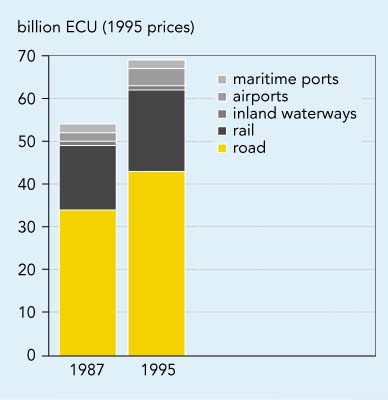Group 4: Transport supply
 positive trend (moving towards objective)
positive trend (moving towards objective)
 some positive development (but insufficient to meet
objective)
some positive development (but insufficient to meet
objective)
 unfavourable trend (large distance from
objective)
unfavourable trend (large distance from
objective)
? quantitative data not available or
insufficient
Group policy context
Traditionally, EU transport policy has been
concerned with providing transport infrastructure and services to
support the development of the internal market and ensure the proper
functioning of the Community’s transport systems. Transport
infrastructure investments are also seen as important in reducing
disparities between the regions. Infrastructure investment is claimed
to have socio-economic benefits such as job creation and productivity
improvement, but the evidence for this is weak and disputed
(DETR/SACTRA, 1999).
Transport investment policies during recent
decades have focused on extending infrastructure, particularly roads,
as a response to increasing traffic demand. However, the assumption
that investment should keep pace with traffic growth is more and more
questioned, in particular since there is evidence that new transport
infrastructure (particularly roads) generates demand, and often serves
simply to shift congestion problems from one place or point in time to
another (ECMT, 1997).
More recently the CTP has introduced certain
‘sustainability’ objectives, such as using existing infrastructure more
efficiently and re-directing demand towards modes with spare capacity
(and with environmental and safety advantages). The development of an
integrated transport system (the TEN), the revitalisation of rail,
combined transport and inland waterways should contribute to
this.
The key EU infrastructure strategies
are:
- Master plans for the multi-modal
trans-European transport Network (TEN), first outlined in the ‘TEN
guidelines (CEC, 1996c). The main objective of TEN is to develop a
better integrated transport system in the EU, and hence to contribute
to growth, competitiveness and employment in Europe, with the
additional aim of improving economic and social cohesion by better
linking of peripheral regions to EU networks.
- The Commission is preparing a White Paper on
the future revision of the TEN guidelines to complement the new
financial regulation recently proposed in the context of Agenda 2000.
This revision will also prepare for the extension of the TEN to
applicant countries through the Transport Infrastructure Needs
Assessment process (TINA).
- The Commission’s strategy for revitalising
the Community’s railways includes initiatives such as the launch of
‘freight freeways’ and the Directive on the inter-operability of the
trans-European high-speed rail system.
- The Commission has also proposed new rules
for combined transport and will put forward proposals and actions to
develop intermodal transport further.
Group findings
Figure 4.1: Investments in transport
infrastructure in bn ECU (EU)

Source: European Conference of Ministers of Transport
(1999)
- Current investment plans only partially
reflect the Community aim of promoting rail and inland waterway
transport. The allocation of investment between road and rail has
remained virtually constant since 1987, with road accounting for some
62 % of investments and rail about 27 %. But the much higher
level of road investment has resulted in a transport network dominated
by road.
- While infrastructure length is only a proxy
measure for capacity, the steady increase in the length of the road
infrastructure since 1970 (with motorways growing by more than
50 % while the length of conventional railway lines and inland
waterways decreased by about 8 %), shows that road capacity has
expanded to the detriment of rail and inland waterways.
- Although rail receives a larger share of
total investment than its share of total transport demand, this has not
been enough to counter the gradual reduction in the supply, quality and
reliability of rail in some countries. The extension of high-speed rail
infrastructure is however expected to enhance the capacity of the rail
system (between 1990 and 1997, the length of the high-speed links of
the TEN rail programme increased by 150 %).
- TEN investment has focused on rail and roads
(39 % and 38 % respectively of total investment in 1996/97),
with airports taking nearly 16 % and seaports and inland waterways
only 7 %. The TEN road programme is well ahead of the
corresponding rail programme. In 1996/97, 55 % of total Community
TEN funding was for road infrastructure.
- No strategic assessment of TEN’s
environmental and socio-economic costs and benefits has yet been
undertaken.

Document Actions
Share with others